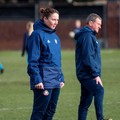Creativity in the final third
This session has been designed to make players think about making better decisions and it encourages them to be more ruthless in the final third of the pitch.

| Area | Up to 80x50 yards |
| Equipment | Balls, bibs, cones, 4 mannequins, 4 mini goals, 2 full size goals |
| No. of Players | Up to 15 players + 2 goalkeepers |
| Session Time | Passing drill: 12mins Possession game: 18mins Small-sided game: 16mins |
This session has been designed to make players think about making better decisions and it encourages them to be more ruthless in the final third of the pitch. There are three different parts to the session that all build towards the real game and look specifically at cues and triggers from the centre forwards and central midfielders. It builds the same vocabulary to ensure players are on the same page.
We have done similar drills in previous sessions and I feel the three parts of the session presented here will really connect together and hopefully bring real game pictures to life after we have rehearsed the movements and patterns.
This session would usually be delivered on a Wednesday, which is an extensive day for us – it should be the hardest session of the week. We are looking at big pitch sizes and longer durations. Players should be looking to cover seven to eight kilometres in this session, with plenty high speed running.
“There are three different parts to this session that all build towards the real game”
PASSING DRILL
After a 20-minute warm-up with the physical performance coach [not shown], we set up a playing area of 25x25 yards for a passing drill, with four mannequins positioned across the middle, representing a defensive back line, as shown. Four cones are placed a yard into the playing area from each corner.
We are using 15 outfield players: four behind one cone and three behind each of the other cones, and two centre forwards are positioned in the middle of the playing area.
The ball starts in the bottom left-hand corner and the first player passes it up the side of the area. The receiving player at the top has a first touch inside and then passes the ball into the centre forward. The centre forward’s first touch must break the line of mannequins and then the striker follows the ball and plays it diagonally to a player in the bottom right-hand corner. The move then starts again, as shown [1a].
[1a]

- The ball starts in the bottom left-hand corner and the first player passes it up the side of the area. All players follow their pass to the next position
- The receiving player at the top has a first touch inside and then passes the ball into the centre forward
- The centre forward’s first touch must break the line of mannequins. The player then follows the ball and plays it diagonally to a player in the bottom right-hand corner
- The move then starts again from the bottom right-hand corner player
We would perform this with two balls running at the same time, with players following their pass to a new position. We would run this drill for four minutes.
As a progression we would run the drill again. However, when the centre forward receives the ball, this time they must pin and spin any one of the mannequins, as shown [1b].
[1b]
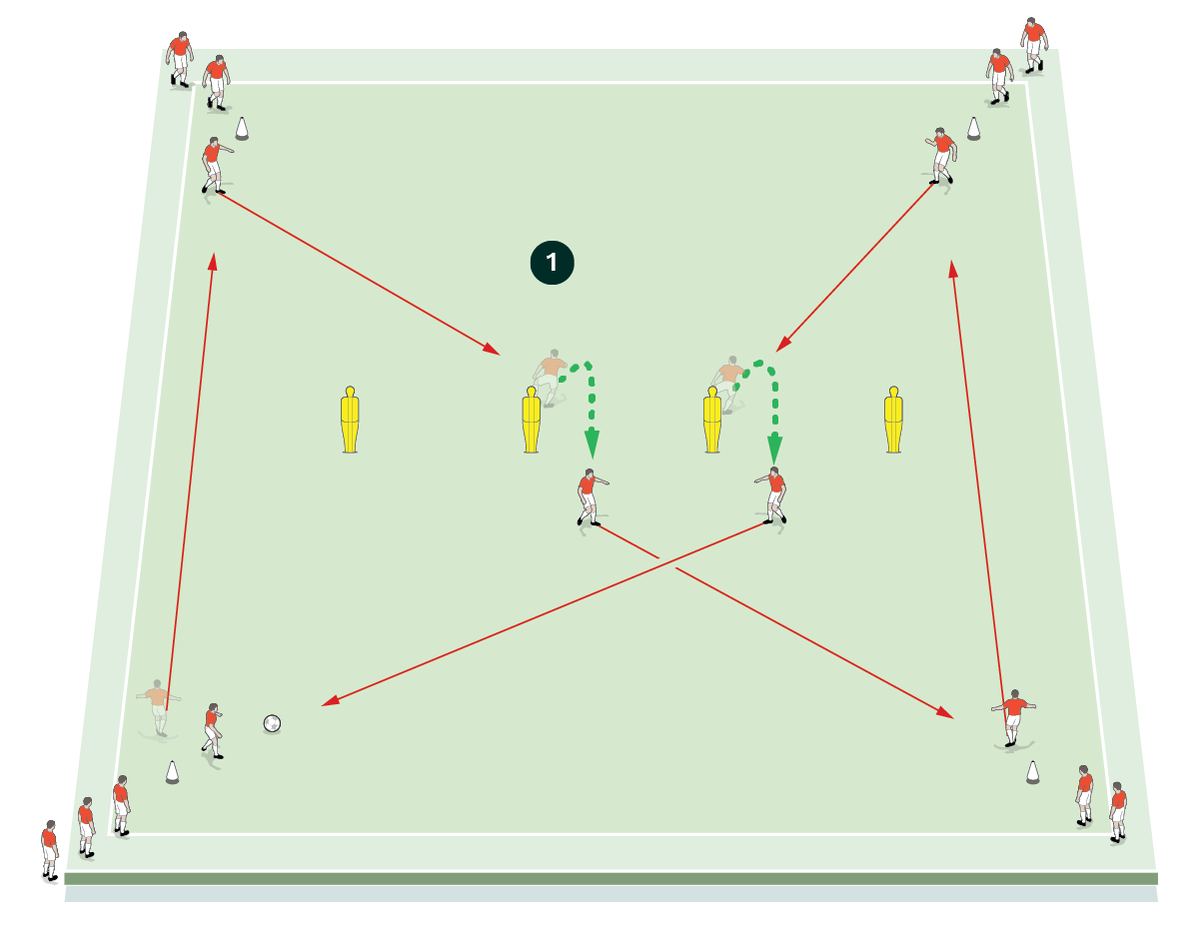
- As a progression we would run the drill again. However, when the centre forward receives the ball, this time they must pin and spin one of the mannequins before receiving and making the final diagonal pass
Then they play the ball diagonally to the bottom right hand corner player as before and the move would start again.
We would run this drill for four minutes with two balls running at the same time and with players following their pass to a new position each time.
As a further progression we would run a third version but this time the centre forward makes a movement towards the second player to create space behind to run into. The second player then plays a through ball for the centre forward, who passes diagonally to the bottom right-hand corner player for the move to start again, as shown [1c].
[1c]
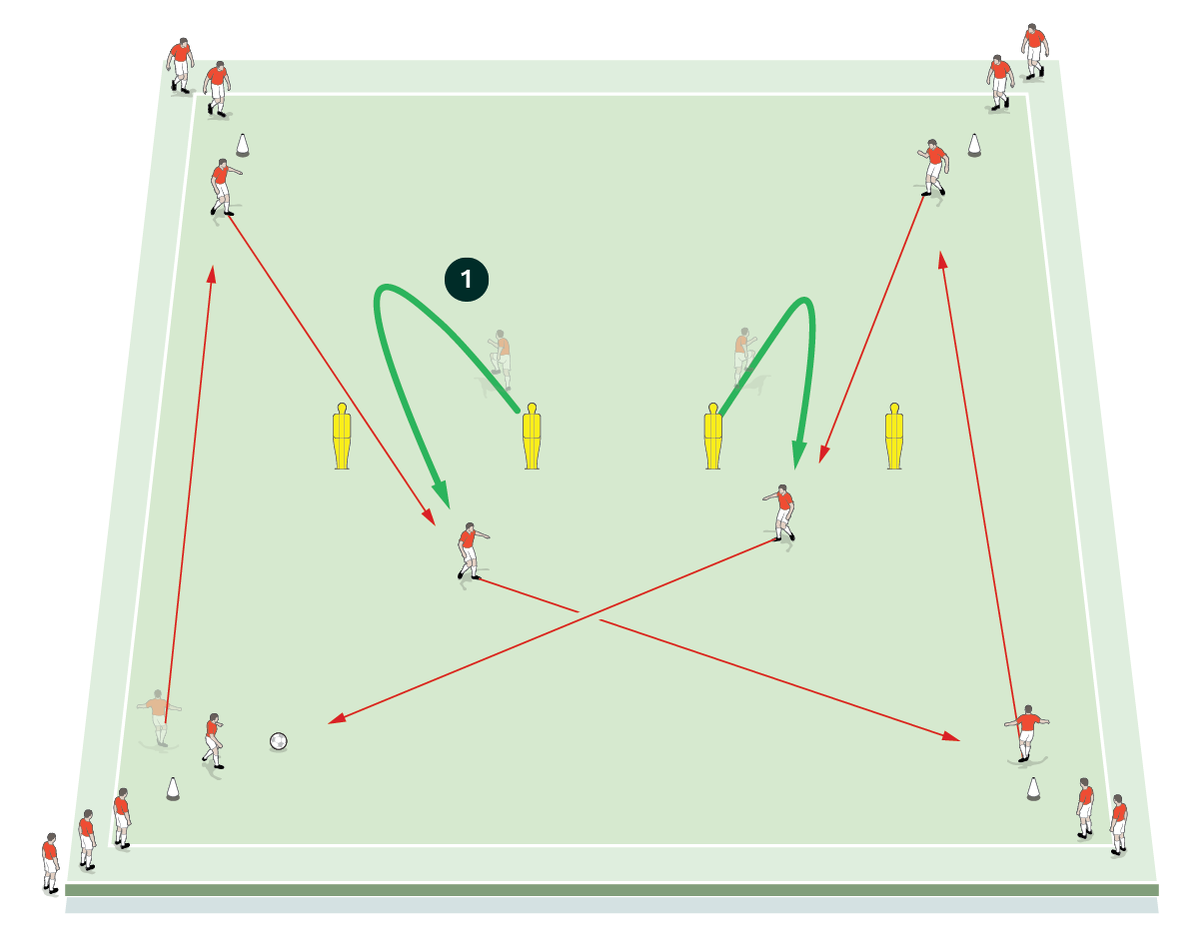
- As a further progression we would run a third version of the drill but this time the centre forward makes a movement towards the second player to create space behind to run into and receive
We would run this drill for four minutes with two balls. Players follow their pass to a new position each time.
POSSESSION GAME
We set up a playing area of 80x50 yards with a halfway line and two 15-yard end zones split into two. A pair of mini goals are positioned at each end.
We’re using 16 outfield players split into two teams of eight. The red team starts with the ball in their defensive end zone and they must try to work the ball into the end zone at the opposite end of the playing area, as shown [2a], while the blue team defend against the attack.
[2a]
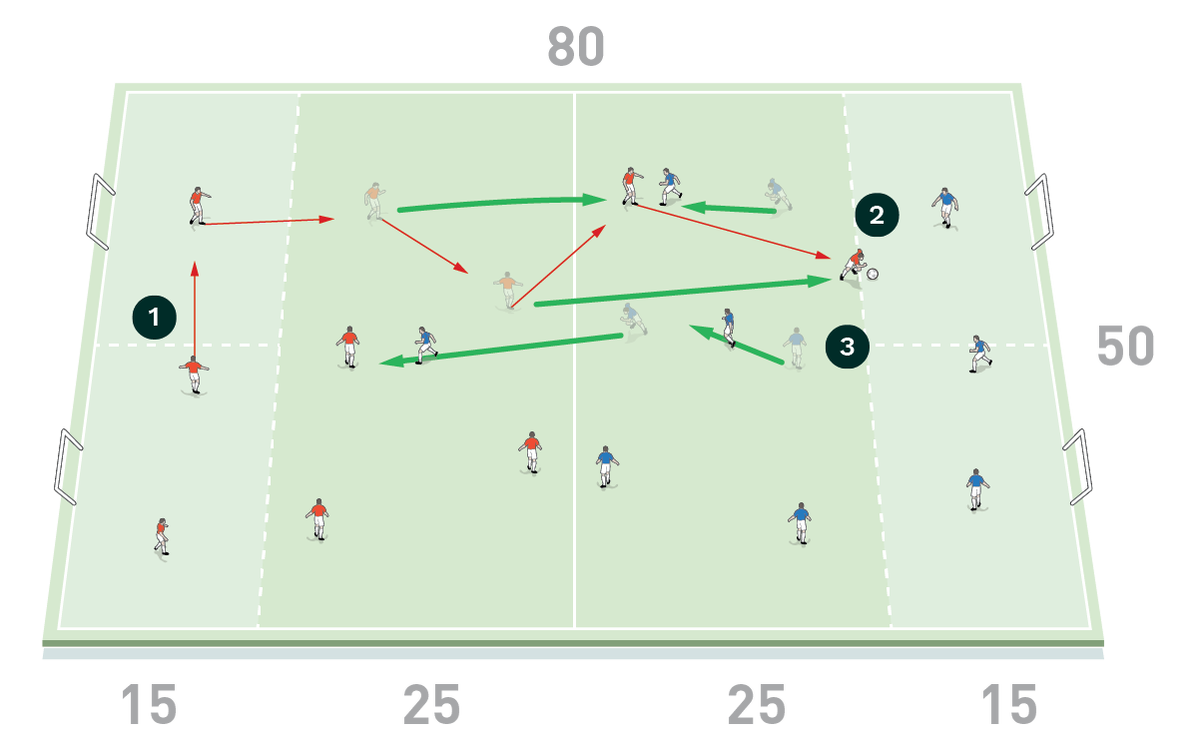
- The red team starts with the ball in their defensive end zone
- The reds must try to work the ball into the end zone at the opposite end of the playing area
- The blue team defend against the attack and if they win the ball they should counter-attack
Once in the final third, players must look to keep the ball there to sustain the attack and to score they must switch the point of attack into the other side of the end zone, as shown [2b].
[2b]
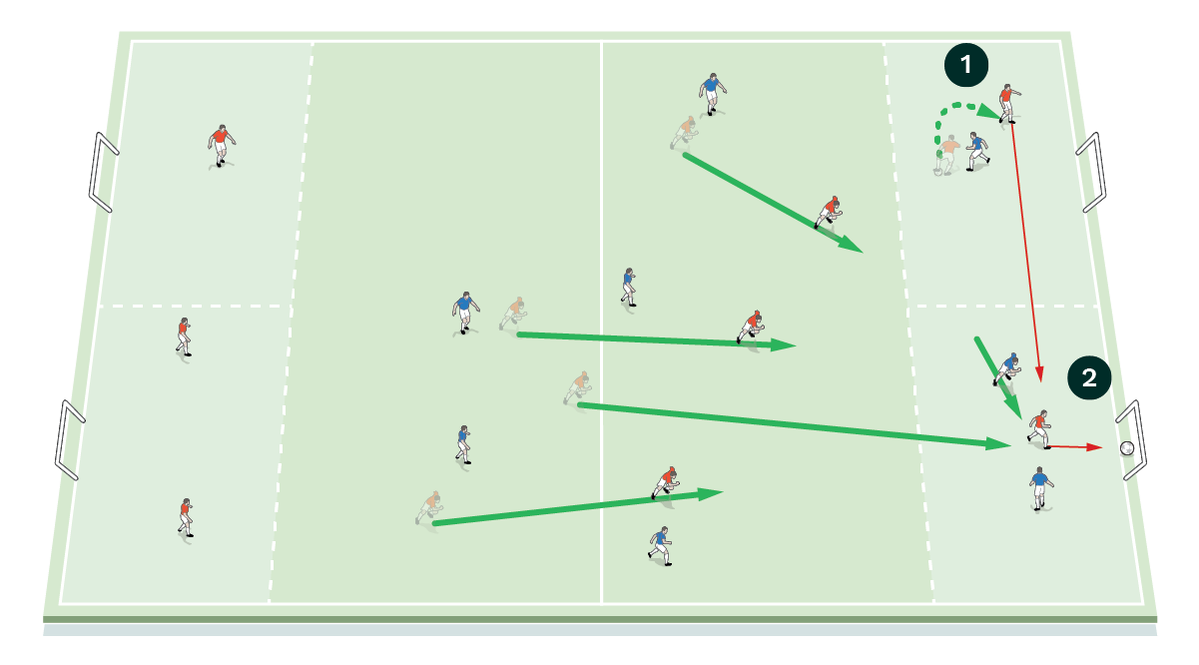
- Once in the final third, players must look to keep the ball there to sustain the attack
- To score the attacking team must switch the point of attack into the other side of the end zone before they can shoot at goal
If the blue team wins possession of the ball, they must counter-attack the other end.
This practice is all about getting into the end zone and supporting the play. There are no goalkeepers so defenders need to squeeze. We want to see players being patient in the build-up and when they get into the final third, they shouldn’t play the ball back. They should be aggressive with their runs and their decision making in order to sustain attacks.
The game runs for three rounds of six minutes.
SMALL-SIDED GAME
Using the same basic 80x50-yard set-up as in the previous activity, we replace the mini goals with a full size goal at each end. Each goal now has a goalkeeper. We’re using 16 outfield players split into two teams of nine including goalkeepers.
The red team starts with the ball and for the first four minutes of each half the ball should constantly be in play. If the ball goes out, as shown [3a].
[3a]

- The red team starts with the ball and for the first four minutes of each half the ball should constantly be in play
- If the ball goes out, the coach immediately plays a ball in to the opposition to restart the game
The coach immediately plays a ball in to the opposition to restart the game, as shown [3b].
[3b]

- Here the coach immediately plays a ball in to the blues to restart the game
- Players still have to be in the final third to score
Players still have to be in the final third to score and we are looking now to combine elements of the two previous practices, looking at the cues and triggers for runs into final third. We want to see players being decisive on the ball and picking the best option. They should be brave and play smart passes, while from a physical point of view we are looking to cover great distances to replicate the demands of a match day game.
We play two games of eight minutes.
COACHING POINTS
What are the key things to look out for?
The main outcome of the session is to see success in the final third, with more effective entries into the box, shots at goal and goals scored. We want to ensure players are using verbal and non-verbal cues to communicate with each other. Building relationships takes time and these triggers can continually be developed each week through any drills we may deliver.
What are the typical mistakes players might make and how do I avoid them?
Players might pick the wrong pass or might not put the correct detail on the pass, and sometimes players might not get their head up early enough to see the run. We all know players have very limited time to make their decisions when entering the final third and they also may have more than one option to choose from, so they need to work on choosing the right option.
Editor's Picks
Attacking transitions
Deep runs in the final third
Using the goalkeeper in build-up play
Intensive boxes drill with goals
Penetrating the final third
Creating and finishing
My philosophy
Pressing initiation
Compact team movement
Coaches' Testimonials

Alan Pardew

Arsène Wenger

Brendan Rodgers

Carlos Carvalhal

José Mourinho

Jürgen Klopp

Pep Guardiola

Roy Hodgson

Sir Alex Ferguson

Steven Gerrard
Coaches' Testimonials

Gerald Kearney, Downtown Las Vegas Soccer Club

Paul Butler, Florida, USA

Rick Shields, Springboro, USA

Tony Green, Pierrefonds Titans, Quebec, Canada
Join the world's leading coaches and managers and discover for yourself one of the best kept secrets in coaching. No other training tool on the planet is written or read by the calibre of names you’ll find in Elite Soccer.
In a recent survey 92% of subscribers said Elite Soccer makes them more confident, 89% said it makes them a more effective coach and 91% said it makes them more inspired.
Get Monthly Inspiration
All the latest techniques and approaches
Since 2010 Elite Soccer has given subscribers exclusive insight into the training ground practices of the world’s best coaches. Published in partnership with the League Managers Association we have unparalleled access to the leading lights in the English leagues, as well as a host of international managers.
Elite Soccer exclusively features sessions written by the coaches themselves. There are no observed sessions and no sessions “in the style of”, just first-hand advice delivered direct to you from the coach.

